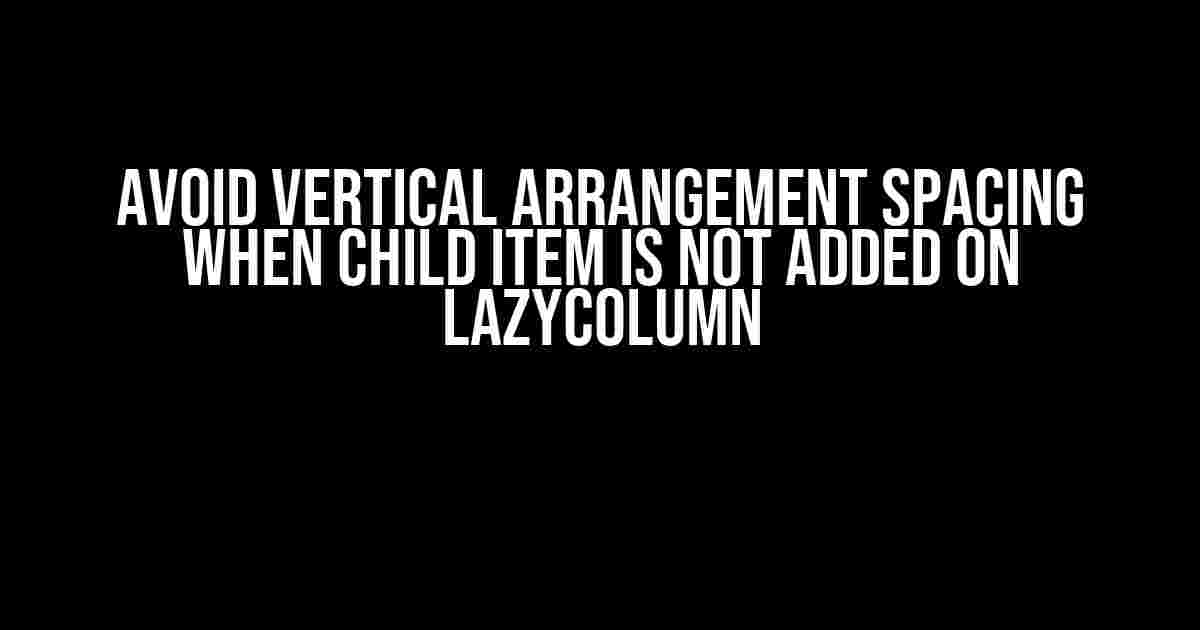Are you tired of dealing with pesky vertical arrangement spacing issues in your LazyColumn layout? You’re not alone! Many developers face this problem when working with Jetpack Compose, and it can be frustrating to find a solution. But fear not, dear reader, for in this article, we’ll explore the reasons behind this issue and provide a step-by-step guide on how to avoid vertical arrangement spacing when a child item is not added on LazyColumn.
The Problem: Understanding Vertical Arrangement Spacing
Before we dive into the solution, let’s first understand the root cause of the problem. In Jetpack Compose, when you use a LazyColumn to display a list of items, it uses a vertical arrangement by default. This means that each item is stacked vertically on top of the other, with a default spacing of 16.dp (density-independent pixels) between each item.
However, when you don’t add a child item to the LazyColumn, this default spacing can cause unnecessary gaps in your layout. This is because the LazyColumn is still rendering the vertical arrangement, even if there are no items to display.
The Consequences
The consequences of this issue can be far-reaching, affecting the overall user experience of your app. Here are a few examples:
- Unnecessary white space: The default spacing can lead to large gaps in your layout, making it look cluttered and unappealing.
- Layout distortion: The vertical arrangement spacing can cause other layout elements to shift or distort, affecting the overall layout structure.
- Performance issues: Rendering unnecessary layout elements can impact your app’s performance, especially when dealing with large datasets.
The Solution: Avoiding Vertical Arrangement Spacing
Now that we understand the problem, let’s explore the solution. To avoid vertical arrangement spacing when a child item is not added on LazyColumn, you can use the following approaches:
Method 1: Using the `verticalArrangement` Modifier
The first method involves using the `verticalArrangement` modifier to adjust the vertical arrangement spacing. You can set the spacing to 0.dp to remove the default spacing entirely.
LazyColumn(
modifier = Modifier
.fillMaxWidth()
.verticalArrangement(Arrangement.spacedBy(0.dp))
) {
// Your items go here
}
This approach is simple and effective, but it has one major drawback: it removes all vertical spacing, including the spacing between items. If you want to maintain spacing between items but remove it when there are no items, you’ll need to use a different approach.
Method 2: Using a Conditional Statement
The second method involves using a conditional statement to check if there are any items to display before rendering the LazyColumn. If there are no items, you can use a spacer or an empty composable to occupy the space.
@Composable
fun MyList(items: List<Item>) {
if (items.isEmpty()) {
Spacer(modifier = Modifier.height(16.dp))
} else {
LazyColumn(
modifier = Modifier.fillMaxWidth()
) {
items(items) { item ->
MyItem(item)
}
}
}
}
This approach is more flexible than the first method, as it allows you to maintain spacing between items while removing it when there are no items. However, it requires more code and can be more complex to implement.
Method 3: Using a Custom Layout
The third method involves creating a custom layout that wraps the LazyColumn and provides a fallback when there are no items to display. This approach requires more code and is more complex than the previous two methods, but it provides ultimate flexibility and customization.
@Composable
fun MyLazyColumn(
items: List<Item>,
modifier: Modifier = Modifier
) {
if (items.isEmpty()) {
Box(modifier = modifier) {
// Fallback content when there are no items
Text("No items to display")
}
} else {
LazyColumn(
modifier = modifier
) {
items(items) { item ->
MyItem(item)
}
}
}
}
This approach requires more code and is more complex than the previous two methods, but it provides ultimate flexibility and customization. You can customize the fallback content to fit your app’s design and requirements.
Conclusion
In this article, we’ve explored the problem of vertical arrangement spacing when a child item is not added on LazyColumn and provided three methods to avoid it. By using the `verticalArrangement` modifier, a conditional statement, or a custom layout, you can remove unnecessary spacing and create a more visually appealing and performant layout.
Remember, the key is to understand the root cause of the problem and adapt the solution to your specific use case. With these methods, you’ll be able to create a seamless user experience and avoid the frustration of dealing with pesky vertical arrangement spacing issues.
| Method | Description | Pros | Cons |
|---|---|---|---|
| Using `verticalArrangement` modifier | Adjusts vertical arrangement spacing | Simple and easy to implement | Removes all vertical spacing, including between items |
| Using a conditional statement | Checks if there are items to display before rendering LazyColumn | Flexible and allows for customization | Requires more code and can be more complex to implement |
| Using a custom layout | Provides a fallback when there are no items to display | Ultimate flexibility and customization | Requires more code and is more complex to implement |
By following these methods, you’ll be able to create a more polished and user-friendly app that avoids the pitfalls of vertical arrangement spacing issues. Happy coding!
Frequently Asked Question
Get ready to dodge the pesky verticalArrangement spacing issue in LazyColumn!
What is the verticalArrangement spacing issue in LazyColumn?
The verticalArrangement spacing issue occurs when you have an empty child item in a LazyColumn, and it takes up unnecessary space, making your layout look awkward. This happens because the LazyColumn arranges its children vertically by default, and when there’s no child item, it still occupies space.
Why does this issue occur in the first place?
This issue arises because the LazyColumn is designed to efficiently handle large datasets, and it doesn’t know when to remove the spacing until the data is actually presented. It’s like having a reserved seat at a restaurant – even if no one shows up, the table is still set!
How can I avoid verticalArrangement spacing when there’s no child item?
To avoid this spacing issue, you can use the `verticalArrangement` modifier with the `Spacing` value set to 0 when there’s no child item. This tells the LazyColumn not to allocate space for an empty child. It’s like canceling that restaurant reservation – no seat, no space!
What if I have a list with both empty and non-empty child items?
In this case, you can use a conditional statement to apply the `verticalArrangement` modifier only when the child item is empty. This way, you can selectively remove the spacing for empty items while keeping it for non-empty ones. It’s like having a dynamic restaurant seating plan – seats are added or removed based on the number of guests!
Is there a better way to handle this issue in the future?
Yes, the JetpackCompose team is working on improving the LazyColumn API to handle this issue more elegantly. In the future, you might be able to use a built-in feature to automatically remove spacing for empty child items. Until then, the workarounds will have to do! Stay tuned for updates!


